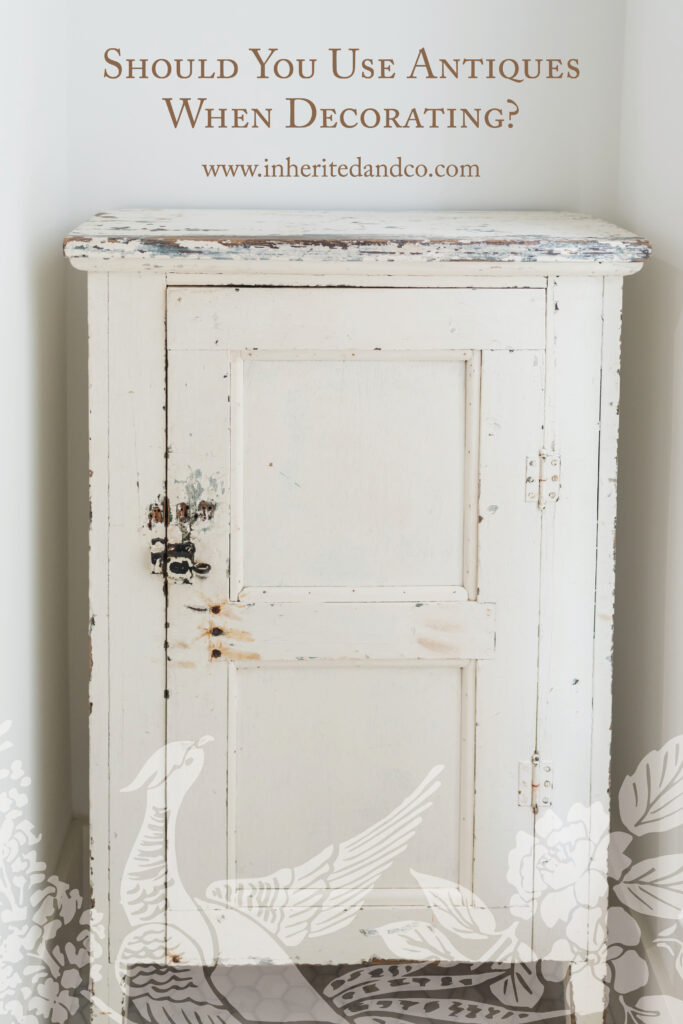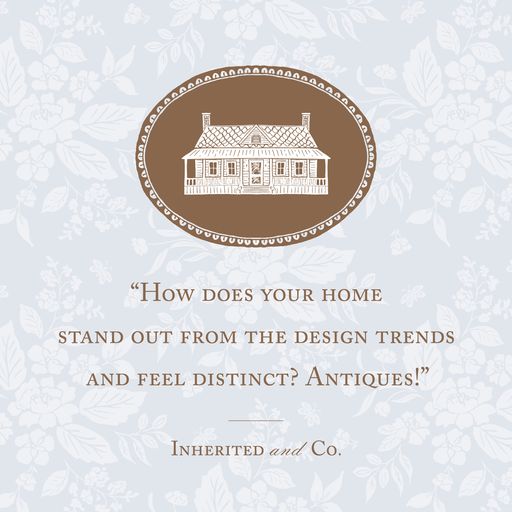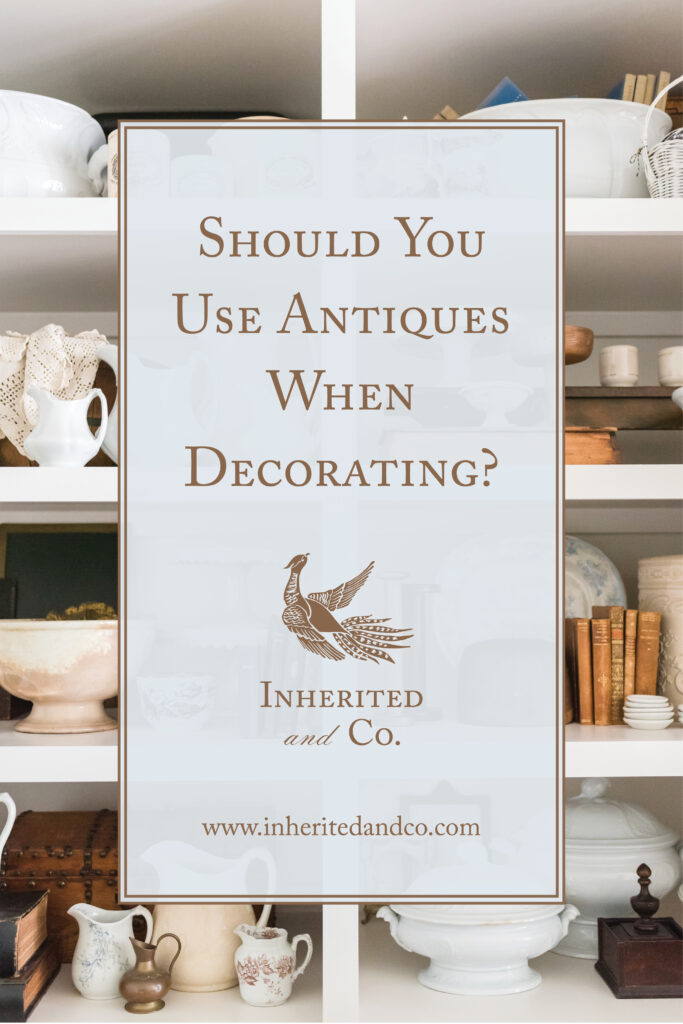Using antiques when decorating has never been a question for me. Growing up, our house was filled with family pieces, antiques from local stores and auctions, and vintage items that my mother and father wanted to keep from their childhoods. Antiques have always been a part of my home décor. In fact, when my husband first started dating me, he said “Take away the television and the computer in this room, and I would not know which century I was in!” Now, I realize I may have more antiques in my home than the average person; however, I’ve been in many houses that do not have even one antique on display, and it shocks me to be quite honest. Decorating with antiques gives you the easiest opportunity to create character in your home, spark conversation, and honor your past.

What Does Antique Mean?
The term “antique” is defined by Merriam-Webster as “a work of art, piece of furniture, or decorative object made at an earlier period and according to various customs laws at least 100 years ago.” That 100-year-old mark is accepted by most antique dealers, but do not think that 100 years defines everything labeled as antique (i.e., cars). We are talking about décor here.
What is the Difference Between Vintage and Antique?
The term “vintage” is more subjective than “antique.” Some people recognize an item that is twenty years old as vintage, while some antique dealers will not consider an item “vintage” until it is at least forty years old.
Why are Antique Items Important?
Either way, antique and vintage items can add value to a home. Value is not only measured monetarily when it comes to antiques, but also there is the value of character, conversation, and honoring the past.
Antiques are Worth Money
Antiques retain their value over time much better than a new purchase would. A new dresser will decrease in value shortly after it leaves the showroom floor. If you have ever searched an online marketplace, you will notice people offering up an item they just purchased for a lower price because the shop will not take returns. This drop in value of a new item can happen within days! Antiques, however, have a stronger chance of maintaining the purchase value. Why? Rarity and quality. A particle board dresser will not hold up over time; therefore, it is not worth the price at which it was purchased for long. A dresser that is held together by craftsmanship (not glue) and created using old growth timber (tighter rings = more durable) has a greater chance of survivability over time, as well as rarity of materials. Now, do antiques ever lose their value? Yes, the antique industry is subject to changes and trends in the market just like any industry, but your chances are greater for an antique to withstand, or rebound from, a market fluctuation than a newer product. Are you still not convinced? Take some time to research the estates of well-known American businessmen, like J.P. Morgan and Cornelius Vanderbilt, to see what they chose to invest their money in when it came to the home.

Antiques Give Instant Character
Not only do antiques retain their value over time much better than a new purchase would, but also antiques give you the opportunity to create instant character. As décor trends are picked up by the masses, people’s homes can start to look the same. It seems like everyone in the 1980s had a brown floral couch, in the 1990s—a burgundy dining room, and in the 2010s—grey flooring. How does your home stand out from the design trends and feel distinct? Antiques! Buying something that not everyone can find will give your home an individual feel instantly.

Antiques Are Conversation Starters
I love how antiques in the home can spark conversations with guests. Recently, we had a gentleman in our home repairing our satellite television. He had never seen ironstone footbaths, noticed the ones in our family room, and asked what they were. I was happy to explain as I love talking about ironstone, and that conversation led us to talking about his hobby of raising sheep. Then, he was able to teach me about an item I’ve come across many times at estate sales but did not know what it was—a carder. This wooden and metal device was used to straighten wool, so it can be used for weaving. We both learned something that day all because I had an antique in my home!

Antiques Help You Honor Your Loved Ones
The most significant reason, in my mind, to decorate with antiques is it allows you to honor your loved ones and your unique past. If you are lucky enough to inherit family pieces, displaying and using those items is a special gift and opportunity. Your grandmother, grandfather, or whomever worked to purchase that piece and took enough pride of ownership in it to be able to maintain it and pass it down to you. You can do the same. Maybe you remember sitting on that couch with your grandmother, or having breakfast at the table, or using that china at Christmas? Using that piece, as opposed to selling it, gives you daily reminders of those happy times.
Are Antiques out of Style?
“Aren’t antiques outdated, though?” This is a question I get asked a lot from people outside of my industry. Well, is quality out of style? No, it is not. You might have a vintage piece that could use some adjustments to bring it into alignment with your particular tastes. It might need to be reupholstered or painted, but the quality cannot be reproduced these days for the same about of money. That simple fact means it is worth keeping and using. Now, I would advise you to not redesign an antique unless it was mass-produced, but chances are the antique is not “dated” in a design sense. (Note that I am saying “antique” here, not “vintage.”) Trends repeat themselves, and classics rarely go out of style.
What is Trending in Antiques?
You might be wondering what antiques are trending today. First of all, note that trends can vary not only by time but also by location. I will speak to trends in my area of middle Tennessee. Since the pandemic, there has been an increase in antique furniture sales, with customers telling us they could not get newer items for months due to shipping delays and chose to buy antique instead. The furniture that is selling is mostly brown furniture compared to painted pieces of the last few years. Finer antiques are going out of the door faster than more rustic pieces. This trend is not exclusive to furniture but includes “smalls” as well. Speaking of smalls, ironstone is selling very well and so are Persian rugs.

Can you mix Modern with Antiques?
You understand the value of an antique and like the antique trends you are seeing, but your decorations are mostly modern. You ask yourself—“Can you mix modern with antiques?” The simple answer is “yes.” If you see an antique you like, chances are you can make it work with your current décor. I have seen antiques paired with many design styles. In fact, my previous neighbor blended farmhouse style pieces with glam. Envision chippy whites and acrylic—it was unique and beautiful.
How do you Incorporate Antiques in a Modern House?
If you are still wondering how to mix modern and antique items, I would suggest you consider three options when incorporating your first antique into your home.
Use an Antique on a Shelf or in a Display Case
Option one is to use the antique on a shelf or in a display case. Chances are you already have items in this location. Replace one item with an antique. Maybe you have a white pitcher you can replace with an ironstone pitcher? Maybe you have a mass-produced sign that could be replaced with an old trade sign? Maybe you have a sculpture that could be replaced with a piece of Early American folk art? Or maybe you want to simply add an antique to a less-than-full shelf? If the piece is your only older item there, it may stand out compared to the others. In that case, I would make sure it is in the center of the shelving unit or cabinet in order to maintain the balance. Then, as you add more antiques into your collection, you can spread them throughout the unit for a blending of old and new that looks intentional.

Display Antiques in Groupings
Speaking of collections, that is my second suggestion for adding antiques to a modern home. Start with a grouping of some sort. Maybe a group of old paintings that match your color palette and would fill an empty wall? Maybe a trio of vintage candlesticks that could help add a warm glow to your bedroom dresser? Maybe a pair of cast iron planters to flank the front door? It could be one small antique feels out of place to you, but a grouping helps the choice feel more deliberate, making the style shift easier to visually accept.
Make an Antique the Focal Point of the Room
The third suggestion is a bold one if you have never owned or lived with an antique. Make an antique the focal point of the room! You could do this with a piece of furniture easily. An early chest of drawers would be beautiful in an entryway, with your more modern furnishings really helping to let it shine in the space. Keeping with the entryway theme, if you don’t want to invest in antique furniture just yet, try an antique oil painting there instead or an antique Persian rug. Both of those items are big and bold and could serve as a lovely focal point, but they are equally easier to relocate to another room if you needed.
Antiques add Value to any Design Style
Antiques are a sound choice for decorating your home. They are a good investment and provide unique opportunities for character, conversation, and an honoring of the past. The trends in design will always allow space for antiques due to their classic nature, with a vintage piece being easily adjusted to meet a more modern aesthetic. If you are new to the world of antiques in home décor, try using an antique on a shelf, displaying a pair or grouping, or go bold and make an antique the focal point of your room.
What are you left wondering about decorating with antiques?
Let me know below if you try any of these suggestions. Happy Antiquing!


Hello- Just found your website! I am an antiques dealer and I loved your post! I love incorporating antiques in my home decor. Thank you for sharing so many good tips and ideas.
Thanks, Anna! Glad you were able to take away something from the post. Where do you sale antiques?